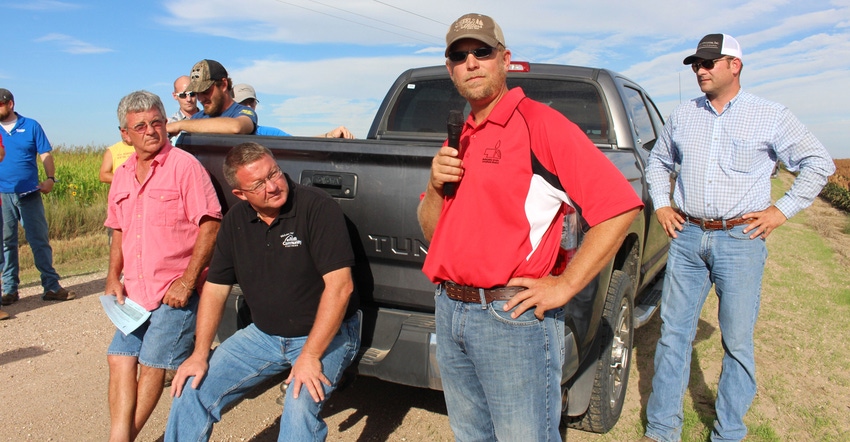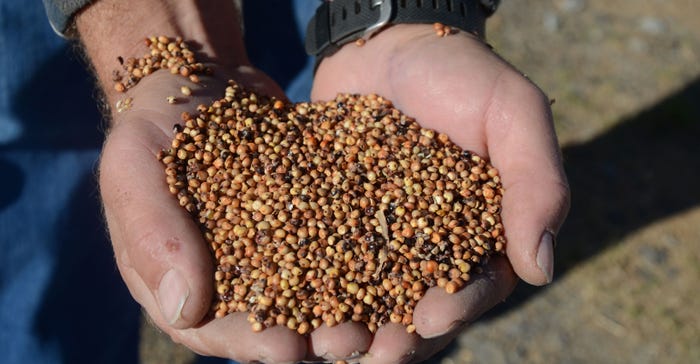
Sorghum saw a surge in acres last year – an increase of about 22.4% nationally, largely driven by the demand from China. In Nebraska specifically, sorghum acres harvested for grain increased from 160,000 acres in 2014 to 240,000 in 2015, according to data from USDA's National Agricultural Statistics Service.
Those acres may not be as high now that the premium isn't there, but Mike Baker has raised sorghum on his farm near Trenton for about 15 years, notes it's still an opportunity to capitalize on the resilience and drought tolerance of the crop, and the benefit of a diversified rotation.
One of the challenges in increasing sorghum acres is achieving higher yields – and this means treating it like a high-yielding crop. As Baker puts it, "You have to put the effort and time into it, to look at it from all aspects of growing as a high-profiting, high-yielding crop." "For a lot of people it's always been treated as a secondary crop," he adds.
This includes everything from weed control to fertility to hybrid selection. "This year I was especially tickled pink," Baker adds. "We cracked the 150-bushel-per-acre mark, which was huge for me. Last year we were at 149 bushels, and this year we were at 152 in the top-yielding hybrid. I'm happy to show people on my farm that we're capable of having those kinds of dryland yields."
Here's a look at some of Baker's tips for achieving high-yielding sorghum:
It starts with hybrid selection. "The 150-bushel mark isn't out of range with the right hybrid, in the right year for dryland," Baker says. "With the right hybrid, irrigated acres can reach 180 to 190, and you save one-third of the water you would use for corn."
In Nebraska, where the growing season is slightly shorter than our neighbors on the southern High Plains, hybrid selection with the right maturity can make a big difference. That's why Baker tries to spread out his hybrids — diversifying with both short-season and fuller-season hybrids.
"I've had full-season sorghum where it was cold and wet, and we were trying to cut milo into mid-November," Baker says. "With short-season sorghum, I'll sacrifice some yield, but it'll dry down and be mature before the snow starts flying. I'll typically plant 80% of my acres with what I consider a shorter-season and 20% with a fuller-season hybrid. Then I do have the bin capacity to accommodate."
Weed management is key. "Weed control is probably one of the foremost issues we have for growing in this area," Baker says. "I generally tell people you're going to get out of the crop what you put into it."
This might mean a cost of around $20 to $30 per acre. For Baker, this includes a fall burndown application with atrazine to kill any volunteer wheat, followed by another burndown in spring and a preemerge application of a premix residual herbicide — either Verdict (Outlook and Sharpen) or Lumax EZ (Dual II Magnum, Callisto and AAtrex).
"What people don't understand is there are good weed control products out there, but they're expensive," Baker says. "I tell people you're going to have to spend some money on a good chemical program or you're going to be disappointed. You'll get what you pay for. The days of growing milo and just putting down 2 pounds of atrazine at planting just doesn't cut it anymore."
Fertilize for a high-yielding crop. For Baker, this means soil-sampling to meet the sorghum crop's nutrient needs, including the occasional micronutrient like zinc or sulfur.
That's important for Baker, who plants sorghum into wheat stubble after harvesting wheat with a stripper head. This means more residue, and potentially greater nutrient cycling for the subsequent sorghum crop. "For example, this year it's all going into wheat stubble I grew 90-plus-bushel wheat on," he says. "The yield recommendation was 120 bushels per acre, and the soil lab is recommending 100 pounds of nitrogen and 40 pounds of phosphorus."
"You really need to pull soil samples; that's the simplest way to know what you need. And soil samples are relatively inexpensive," Baker adds. "That way you'll know exactly what you need, rather than putting on an extra 20 pounds of nitrogen."

TIME AND EFFORT: For many growers, sorghum is a secondary crop. But achieving higher yields means treating it like a high-yielding crop. "You have to put the effort and time into it, to look at it from all aspects of growing as a high-profiting, high-yielding crop," says Mike Baker.
About the Author(s)
You May Also Like






